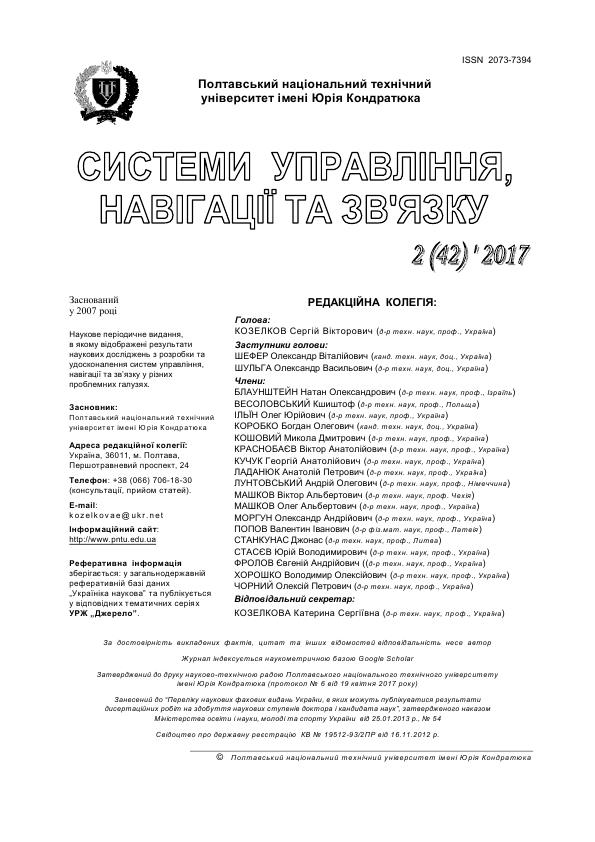ВДОСКОНАЛЕННЯ МЕТОДУ ЕНЕРГЕТИЧНОГО БАЛАНСУ LEACH НА ОСНОВІ ГЕНЕТИЧНОГО АЛГОРИТМУ
Ключові слова:
енергоспоживання, протокол LEACH, час життя мережі, генетичний алгоритм, середовище OpnetАнотація
У більшості реалізацій сучасних безпровідних сенсорних мереж нерухомі вузли використовуються для розподілення інформації, що призводить до збільшеного розходу енергії сенсорами, що пов’язані з такими вузлами, а також сенсорами, що розміщені на маршрутах такого інтенсивного трафіку. Таким чином, через деякий час мережне середовище стане фрагментованим. Отже, використання мобільних станцій в безпровідних сенсорних мережах покращує енергетичний баланс серед усіх сенсорів в зоні обслуговування. Це призводить до збільшення часу життя сенсорів та, в результаті, до пролонгованого часу життя мережі. В статті запропоновано вдосконалений метод для протоколу LEACH (LEACH-TLCH), що дозволяє збалансувати енергоспоживання всієї мережі та збільшити час життя мережі. Моделювання вдосконаленого методу виконано у середовищі Opnet; результати моделювання підтвердили покращені характеристики енергоефективності та часу життя мережі.Завантаження
Посилання
Tyagi S, Kumar N. A systematic review on clustering and routing techniques based upon LEACH protocol for wireless sensor networks. Journal of Network and Computer Applications. 2013 Mar 31;36(2):623-45.
N. Saini and J. Singh , “ A survey: hierarchical routing protocols in Wireless Sensor Networks ”, Global Journal of Computer Science and Technology (E) , vol. 14 , no. 1 , pp. 33 – 39 , 2014 .
Parul Khurana and Inderdeep aulakh,“Wireless Sensor Network Routing Protocols: A Survey”, International journal of computer applications, vol.75, Issue No. 15, 2013.
Vibha Nehra and Ajay K. Sharma,” PEGASIS-E: Power Efficient Gathering in Sensor Information System Extended ”Global Journal of Computer Science and Technology Network, Web & Security Volume 13 Issue 15 Version 1.0 Year 2013
Harneet Kour and Ajay K. Sharma. “ Hybrid Energy Efficient Distributed Protocol for Heterogeneous Wireless Sensor Network”, International Journal of Computer Applications (0975 – 8887) Volume 4 – No.6, July 2010.
Md. Faruqul Islam, Yogesh Kumar, saurabh ,“Recent Trends in Energy Efficient Clustering in WSN”, International Journal of Computer Applications, vol. 95, Issue No.20, pp. 44-48, 2014.
Pankaj Chauhan and Tarun Kumar,“Power Optimization in Wireless Sensor Network: A Perspective", International Journal of Engineering and Technical Research (IJETR), vol. 3, issue-5, May 2015.
C. Zhang, F. Liu and N. Wu, “A Distributed Energy-efficient Unequal Clustering Routing Protocol for Wireless Sensor Networks”, Int. Journal of Computational Information Systems, vol. 10, no. 6, (2014) March, pp. 2369- 2376
Asha Alawat and Vineeta Malik,“An Extended Vice-CH Selection Appraoch to Improve LEACH Protocol in WSN”, IEEE 3rd International Conference on advance Computing & Communication technologies, pp.236-240, 2013.
Vipin Pal, Yogita, Girdhari Singh, RP.Yadav,“CH Optimization based on Genetic Algorithm to prolong lifetime of WSN”, Elsevier: third international conference on recent trends in computing, pp. 1417-1423, 2015.
Chunyao FU, Zhifang Jiang, Wei Wang,“An Energy Balanced Algorithm of LEACH Protocol in WSN”, International journal of computer science IJCSI,vol. 10, issue 1, No. 1, 2013.
Ali Jorio, Sanaa El Fkihi, Brahim Elbhiri, and Driss Aboutajdine, “An Energy-Efficient Clustering Routing Algorithm Based on Geographic Position and Residual Energy for Wireless Sensor Network”, Journal of Computer Networks and Communications, Volume 2015.
F. Li and J. Wang, “A Best Clustering Scheme Based on Simulated Annealing Algorithm in Wireless Sensor Networks”, Chinese Journal of Sensous and Actuators, vol. 24, no. 6, (2011) pp. 900-904.
A Razaque, KM. Elleithy, "Energy-efficient boarder node medium access control protocol for wireless sensor networks", Sensors, vol. 14, no. 3, pp. 5074-117, Mar. 2014.
Agrawal Palak, P. R. Pardhi, "Routing Protocols For WSN", International Journal Of Computer Science And Applications, vol. 8, no. 1, 2015.
OPNET Technologies Ltd. WWW-page, http://www.opnet.com




